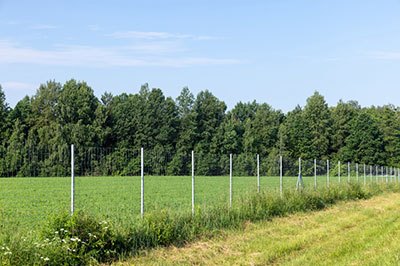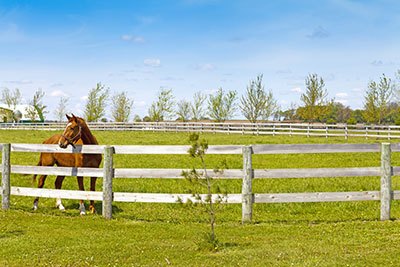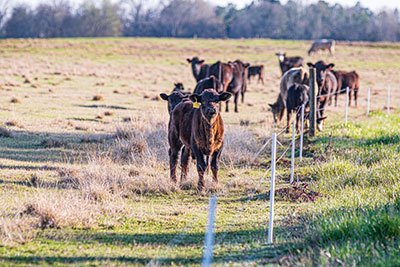Good fencing is one of the keys to a successful farm and ranch. It’s essential for containing livestock and protecting them from predators, or vice versa.
However, many don’t consider possibilities that could make all the difference when constructing new fences. Some small mistakes add up to cause major headaches down the line!
In this post, we’ll look at common fencing problems and propose solutions so you can avoid them altogether and create the perfect fence no matter your needs.
Take away key points:
- Be aware of fence requirements to make sure they are optimal
- Ensure you know the proper place of your fence, T-posts, top wire, and other elements to avoid errors to cost you more than necessary
- Find the common fencing errors below to avoid them
Table of Contents
Most common fencing mistakes for beginners & experts
If you need to learn the proper fence installation to eliminate the common cattle fencing mistakes and keep your and your neighbor’s property optimal, you should read our guide.
We present the common errors to avoid, and how to fix them.
Mistake #1: Incorrectly placed fence

In rural areas, you may have flexibility when it comes to building a fence to define your property. However, if you have neighbors nearby, it’s crucial to pay attention to your property line to avoid boundary conflicts that could damage your relationship with them permanently.
It’s advisable to seek assistance from a utility company to establish your land’s accurate placement and property lines before you start building your fence.
It’s essential to keep an open dialogue with your neighbors and double-check all local zoning laws and requirements before you start installing fences. Most people may have a different understanding of the property lines. Make sure to build the fence slightly inside the boundary line.
Mistake #2: Incorrectly placed gate
When installing a gate, the main objective is to create a passage between the outside and your property. If your yard has a walkway, the position of your gate should be obvious, and it should enable smooth traffic flow and movement.
The direction in which the gate should open should also be determined by the traffic flow. When installing such gates, two critical factors must be considered.
Firstly, ensure that the gate’s location facilitates proper drainage to avoid the entryway being flooded. Secondly, driveway gates should be installed with enough space, providing room for cars to get out of the road before reaching the gate opener. If you install the gate at the wrong spot in the wrong place, your fence cannot properly protect your land and animals.
For longer fences, specifically in rural areas, the positioning of the gate is crucial. The gate should provide easy access to the paddock while still ensuring the animals can’t escape, and the gate should be located in areas where livestock can move freely between the fenced-in sections.
Mistake #3: Shallow or undersized fence posts
When building a fence, the most important element is the fence posts since they hold the panels upright and support the weight of the fence. If fence posts are not proportionate to the type of fence or aren’t set deep enough, your fence is likely to fail.
Post holes of your fence post depend on the fence type; a light boundary fence requires a narrower post, whereas a more robust fence needs a thicker post. The depth of the fence post should be at least equal to the height of the top of the fence panel.
Ensure the corner posts are stable, as they serve as a corner for your wire fence. The corner posts can be steel posts, wood posts, concrete posts, etc. to keep the fencing system stable and secure for an extended time. Besides, composite posts will resist all weather elements, and keep all other fence posts optimal for more robust uses.
Mistake #4: Failing fence panels or posts
Hiring a licensed fencing contractor can help you avoid the mistakes listed above, but even with an expert installation, you still might face problems. Failed fences are the most common issues with existing fences, primarily due to buckling or broken posts, insect infestations (wooden posts), sagging fence panels, and other related issues.
To prevent these problems, you should inspect your fence regularly and look for signs of damage to panels and corner posts. If you catch these issues early, you can repair them before they worsen to get your right fence standards. However, if you neglect them, the wire fence is likely to fail.
Mistake #5: Irregular fence line maintenance

Maintaining a fence can become tricky if you have neighbors nearby, as the laws related to fencing vary by state and city. According to most ordinances, the fence owner is responsible for the maintenance costs. However, the definition of use can vary among states and cities.
Typically, both neighbors are accountable for maintaining a fence that sits precisely on the boundary between their properties. If you move to a property with an existing fence, you should determine what your responsibilities are for maintaining it.
Mistake #6: Incorrect ground rods
This is one of the most common cattle fencing mistakes for all farmers. If you don’t ground your electric fence properly, it will not have enough power. So, you must ensure enough ground rods for optimal electric conductivity.
It is best to place three feet of ground rods per every joule of electrical energy. The ground rods should be spaced at least ten feet apart, and you don’t need to place them near the energizer. But, most people place them near the charger.
What are horse fencing mistakes to avoid?
Horse fencing is an important part of keeping your horses safe and secure. There are several common mistakes that horse owners make when it comes to fencing, which can lead to accidents or injury for their horses.
Here are some of the most common mistakes to avoid when installing a horse fence:
– Using barbed wire – inappropriate for horses: Barbed wire is not suitable for containing horses as it can cause serious injury if they come into contact with it. Instead, use safer options such as electric fences, woven wire, or high-tensile fences for your fenced area.
– Poor planning: Before you begin installing a fence, take the time to plan out where you want the fence line to be and how much space you need for your horses to roam safely. This will help ensure that your fence is installed correctly and that there are no gaps or weak spots in the fence line.
– Insufficient height: Horses can easily jump over low fences if they get spooked or excited, so make sure your fence is tall enough to keep them contained safely. The recommended height for a horse fence is at least 4 feet high but this may vary depending on the size and breed of your horses.
– Unsecured gates: Make sure all gates leading into and out of pastures are securely closed and locked at all times to prevent any unwanted visitors from entering or exiting the area. You should also check that all hinges and latches on gates are in good condition and working properly before using them.
– Poor ground conditions: If you’re installing an electric fence, make sure the ground conditions around it are suitable for installation by testing the soil with a moisture meter before proceeding with the installation. Poor ground conditions can lead to poor electrical connections which could result in an ineffective electric fence system that won’t keep your horses contained safely.
– Overlooking maintenance needs: Regular maintenance is essential when it comes to keeping your horse fencing in top condition so don’t forget about it! Check all fence posts regularly for signs of wear and tear, replace any broken boards or wires immediately, and inspect all gates regularly too. This is a common mistake, especially after storms or heavy winds have passed through the area. The new fence can weaken fences quickly if left unchecked!
FAQs
What is the hardest part of installing a fence?
Digging the holes for the posts is the hardest part when installing a fence. The rest of the process is pretty effortless.
What is the good and bad side of a fence?
On the positive side, it can provide privacy, security, and safety for those inside the fence. It can also serve as a physical boundary to prevent unwanted intrusion from outside.
However, on the negative side, it can be perceived as a barrier, creating a feeling of isolation and division. Also, it can obstruct views and reduce aesthetic appeal, depending on the design of the fence.
How do I keep my wire fence tight?

Follow the steps below:
– Set up your corner posts, brace posts, and line posts.
– Wrap the wire around the corner post but don’t tie it off yet.
– Use a temporary fence staple to hold it in place while you pull the top of the wire towards your end post and roughly position it where it will be tied off.
– Hold that tight with your body while you staple it in place.
– Pull the top and staple, then the middle, then the bottom.
– Use a permanent fence staple to secure it in place.
Conclusion
There are different steps to be aware of and ensure you don’t make any mistakes with your fencing systems.
Ensure you know how many strands of wire you need, whether you use woven wire or some other, the depth of your steel posts or some other, etc. These help you with proper fencing systems.
